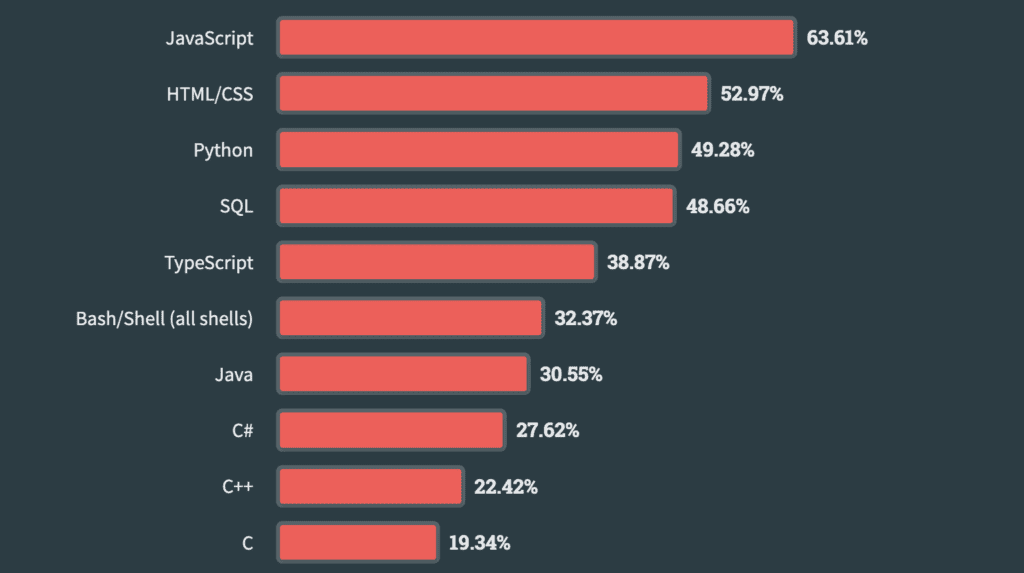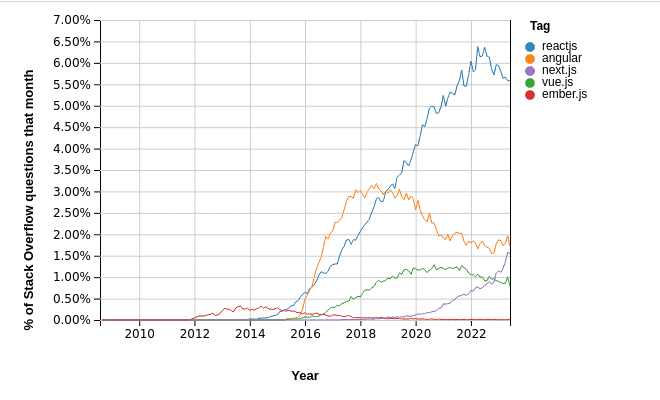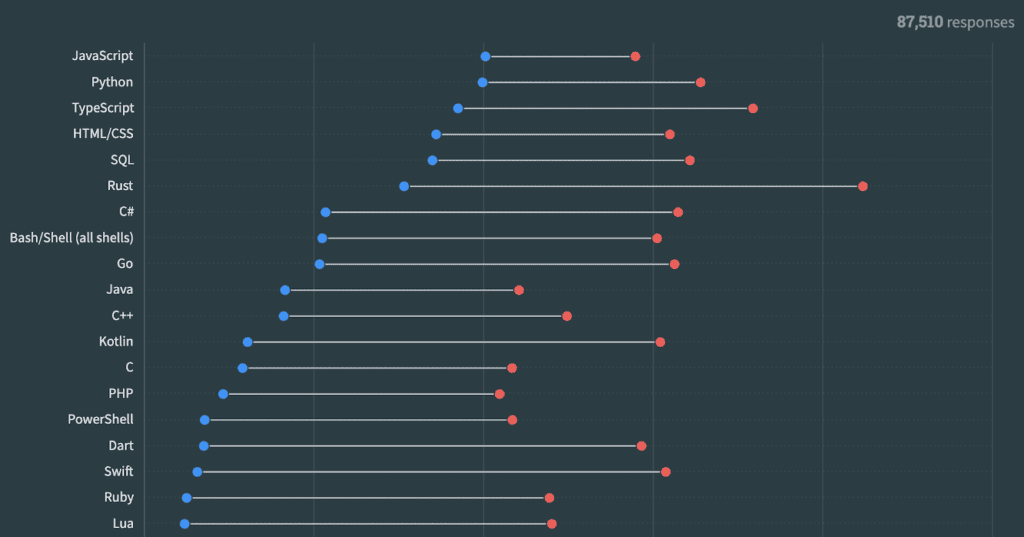JavaScript is a high-level, interpreted programming language primarily used for creating interactive and dynamic web content. It is one of the core technologies of the web, along with HTML and CSS, and is supported by all modern web browsers.
JavaScript was initially designed to add interactivity to web pages. However, it has evolved to become a versatile programming language used for both frontend and backend development. It is now used for building web and mobile applications, server-side development, game development, and more.
What Is a JavaScript Front End Framework?
JavaScript front-end frameworks are pre-written collections of code and libraries that provide a structure and set of tools for building interactive and dynamic user interfaces (UIs) for web applications. They simplify the development process by providing abstractions, patterns, and components to handle common front-end tasks.
Among the top ten programming languages this year, we see popular languages increase their standing.

Front-end frameworks help developers with tasks such as:
- Managing the application state: This includes keeping track of the current state of the application, such as which page is being viewed, what data is being displayed, and what user interactions have taken place.
- Handling routing: This involves determining which page or component should be displayed based on the user’s actions.
- Updating the UI based on data changes: This includes updating the UI to reflect changes in the application state, such as changes in the data being displayed or the user’s interactions.
- Handling user interactions: This includes responding to user input, such as clicks, scrolls, and form submissions.
Front-end frameworks provide a consistent and efficient way to organize and structure the codebase, making it easier to maintain and scale applications. They also provide a large community of developers and resources, which can be helpful for learning and troubleshooting.
5 Best Front End JavaScript Frameworks

1. React
React is an open-source JavaScript library used for building user interfaces (UIs) for web applications. It was developed by Facebook and is widely adopted by developers due to its simplicity, efficiency, and component-based approach. In React, both props and state are used to manage and update data within components.
React serves as a foundational framework for developing single-page and mobile applications. While React primarily focuses on rendering data to the DOM, the creation of React apps typically involves the inclusion of additional libraries to handle tasks such as state management, routing, and API interaction.
One of React’s notable strengths is its high performance, achieved through the use of a virtual DOM. This approach minimizes the time needed to re-render the view when the state changes, resulting in efficient updates.
Additionally, React supports server-side rendering, which enhances web application performance by enabling data fetching before the view is rendered on the client side.
Component-Based Architecture: React follows a component-based architecture, where the UI is divided into reusable and self-contained components. Components encapsulate their own logic, state, and rendering, making them easy to understand, test, and maintain.
Virtual DOM: React uses a virtual Document Object Model (DOM) to efficiently update the UI. It creates a lightweight copy of the actual DOM, allowing React to track and update only the necessary changes. This approach improves performance by minimizing expensive direct DOM manipulations.
Efficient Rendering: React optimizes rendering by performing a diffing algorithm called “reconciliation.” It identifies the differences between the previous and current UI state and updates only the necessary parts of the UI. This ensures efficient and minimal updates, improving performance and responsiveness.
React Hooks: Introduced in React 16.8, hooks are functions that allow developers to use state and other React features in functional components. Hooks provide a simpler way to manage state and lifecycle events without using class components, making code more concise and easier to maintain.
Pros of React
- Components can be easily composed and reused throughout the application, enhancing development efficiency.
- React uses a virtual Document Object Model (DOM) that improves performance by minimizing actual DOM manipulations.
- With React, you can leverage React Native, an extension of React, to build native mobile applications for iOS and Android platforms.
- React has a vast ecosystem of libraries, tools, and community support.
Cons of React
- React introduces new concepts, such as JSX syntax and component lifecycle methods, which may have a learning curve for developers who are new to the library.
- React project involves configuring tools like webpack, Babel, and other build tools. This initial setup process can be complex, especially for beginners.
- React has a relatively fast release cycle, with frequent updates and changes. It may require developers to keep up with the latest updates and adapt their code accordingly.
- If developers are not proficient in JavaScript, they may need to invest time in learning the language alongside React.
- Developers may need to integrate additional libraries or frameworks to handle state management, routing, and other functionalities, depending on the project requirements.
2. Angular
Angular is a popular open-source front-end framework developed and maintained by Google. It offers a comprehensive solution for building large-scale web applications, providing a robust set of features and tools.
Angular is a platform and framework for building single-page client applications using HTML and TypeScript. It is a popular choice for developing web applications because it provides a number of features that make it easy to build complex and dynamic applications.
Components: Angular applications are made up of components, which are reusable pieces of code that encapsulate both the presentation and the logic of an application.
Data binding: Angular provides two-way data binding, which means that changes in the data are automatically reflected in the UI, and vice versa.
Routing: Angular provides a routing system that allows you to define different pages or views in your application and navigate between them.
Dependency injection: Angular uses dependency injection to inject dependencies into your components, which makes it easier to test and maintain your code.
Pros of Angular
- Angular is a comprehensive framework that provides a set of integrated tools and features
- Angular is built with TypeScript, which adds static typing and advanced features to JavaScript.
- Angular’s Command Line Interface (CLI) offers a powerful set of tools for scaffolding, building, and testing Angular applications.
- Angular provides two-way data binding, allowing automatic synchronization of data between the UI and component logic.
- Angular has a large and active community of developers who contribute to its growth and provide support.
Cons of Angular
- Understanding Angular’s concepts, such as modules, decorators, and dependency injection, may require time and effort to grasp.
- Angular’s syntax can be verbose compared to other frameworks, which can lead to more lines of code.
- For small projects or simple websites, Angular’s features and setup may be overkill and add unnecessary complexity.
- Angular enforces a specific project structure and coding patterns.
- Angular’s core framework, along with its dependencies, has a larger footprint compared to some other frameworks.
3. Vue.js
Vue.js is a highly regarded JavaScript library known for its ability to create lightweight and adaptable interactive UI elements. It offers a flexible and user-friendly API for building data-reactive components.
Vue.js is a progressive JavaScript framework for building user interfaces. It is often referred to as a “progressive” framework because it can be adopted incrementally, allowing developers to use it for small parts of a project or scale it up to handle larger applications.
Vue.js follows a component-based architecture and provides a simple and intuitive API for building user interfaces. It emphasizes simplicity, flexibility, and ease of integration. Vue.js can be used to build single-page applications (SPAs), as well as to enhance existing web projects.
Pros of Vue.js:
- Simplicity: Vue.js is a very easy framework to learn. The syntax is straightforward, and the documentation is excellent.
- Performance: Vue.js uses a virtual DOM, which makes it very performant.
- Reactivity: Vue.js is a reactive framework, which means that your UI will automatically update when your data changes.
- Modularity: Vue.js is a very modular framework, so you can pick and choose the components that you need.
- Community: Vue.js has a large and active community. There are many resources available, including tutorials, plugins, and examples.
Cons of Vue.js:
- Lack of support for large-scale projects: Vue.js is still a relatively new framework, so there is not as much support for large-scale projects as there is for other frameworks, such as React and Angular.
- Flexibility: Vue.js is very flexible, which can be a good thing or a bad thing. It can be easy to over-engineer your code if you are not careful.
- Community: The Vue.js community is not as large as the communities for other frameworks, such as React and Angular. This can make it difficult to find help if you are having problems.
4. Ember.js
Ember is a JavaScript framework based on the component architecture, initially developed by Yehuda Katz in 2011. It reached its stable release in 2016, solidifying its position as a mature and reliable framework.
Ember leverages its FastBoot technology to enable server-side rendering for Ember applications. With FastBoot, you can serve pre-rendered HTML pages to browsers and other clients directly, eliminating the need for them to download JavaScript assets first. This approach enhances performance and allows for faster initial page rendering, providing a seamless user experience.
Ember.js provides a full-featured framework with strong opinions on application structure and development practices. It focuses on developer productivity, scalability, and maintainability. Ember.js follows the Model-View-Controller (MVC) architectural pattern and includes features such as data binding, computed properties, routing, and an expressive templating system.
Pros of Ember.js:
- Ember.js has excellent documentation. This makes it easy to learn how to use the framework and to find help if you are having problems.
- Ember.js has a strong focus on conventions, which means that there is a lot of built-in functionality that you can use without having to write a lot of code yourself.
- Ember.js uses a virtual DOM, which makes it very performant. This is especially important for large, complex web applications.
- Ember.js provides a powerful Command Line Interface (CLI) that automates common development tasks such as project creation, code generation, testing, and deployment.
- Ember.js is known for its commitment to stability and long-term support.
Cons of Ember.js
- Ember.js has a bit of a learning curve. It is not as easy to learn as some other JavaScript frameworks. Developers might require more time and effort to become proficient in Ember.js.
- For developers already familiar with other frameworks, adapting to Ember.js may involve unlearning certain practices and adopting Ember-specific patterns.
- Ember.js is a very opinionated framework. This means that it can be difficult to deviate from the conventions of the framework. This can be frustrating for some developers.
- Ember.js can be a bit inflexible. This can make it difficult to customize the framework to your specific needs.
- Ember.js, along with its associated tools and dependencies, has a larger footprint compared to some other frameworks.
5. Next.js
Next.js is a React framework that is designed to make it easy to build fast, SEO-friendly, and scalable web applications.
Next.js is a popular open-source framework built on top of React that enables server-side rendering (SSR) and provides a powerful set of features for building scalable and production-ready web applications.
Automatic server-side rendering (SSR): This means that your pages are rendered on the server before they are sent to the client, which can improve performance and SEO.
Static site generation (SSG): This allows you to generate your pages ahead of time, which can further improve performance.
Routing: Next.js provides a powerful routing system that makes it easy to manage your application’s pages.
Image optimization: Next.js provides built-in image optimization, which can help to improve your application’s performance.
Deployment: Next.js is easy to deploy, and there are a number of hosting providers that offer pre-configured solutions.
Pros of Next.js
- Next.js offers static site generation for generating static HTML files that can be served from a content delivery network (CDN).
- With Next.js, initial page loads are faster due to server-side rendering and automatic code splitting.
- Next.js optimizes web applications for search engines, as pre-rendered pages can be easily crawled and indexed.
- Routing is handled automatically based on the file structure, eliminating the need for manual route configuration.
- Next.js intelligently splits JavaScript bundles based on the pages and components used in each route.
- Next.js includes hot module replacement (HMR) and fast refresh capabilities, enabling instant updates to the application during development.
- The community actively shares knowledge, provides support, and creates tools that enhance the development experience.
Cons of Next.js
- Next.js has a bit of a learning curve, especially if you are not familiar with React.
- Next.js is a bit opinionated, which means that it can be difficult to deviate from its conventions.
- Next.js follows specific conventions and patterns, which might restrict flexibility and customization options.
- For simple websites or projects without much need for server-side rendering or dynamic routing, Next.js might introduce unnecessary complexity.
- Server-side rendering introduces additional server load and complexity compared to purely client-side rendering.
We can see JavaScript, ranked as most popular programming language since 2011.




